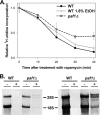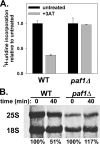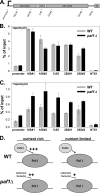The RNA polymerase-associated factor 1 complex (Paf1C) directly increases the elongation rate of RNA polymerase I and is required for efficient regulation of rRNA synthesis
- PMID: 20299458
- PMCID: PMC2863250
- DOI: 10.1074/jbc.M110.115220
The RNA polymerase-associated factor 1 complex (Paf1C) directly increases the elongation rate of RNA polymerase I and is required for efficient regulation of rRNA synthesis
Abstract
The rate of ribosome synthesis is proportional to the rate of cell proliferation; thus, transcription of rRNA by RNA polymerase I (Pol I) is an important target for the regulation of this process. Most previous investigations into mechanisms that regulate the rate of ribosome synthesis have focused on the initiation step of transcription by Pol I; however, recent studies in yeast and mammals have identified factors that influence transcription elongation by Pol I. The RNA polymerase-associated factor 1 complex (Paf1C) is a transcription elongation factor with known roles in Pol II transcription. We previously identified a role for Paf1C in transcription elongation by Pol I. In this study, genetic interactions between genes for Paf1C and Pol I subunits confirm this conclusion. In vitro studies demonstrate that purified Paf1C directly increases the rate of transcription elongation by Pol I. Finally, we show that Paf1C function is required for efficient control of Pol I transcription in response to target of rapamycin (TOR) signaling or amino acid limitation. These studies demonstrate that Paf1C plays an important direct role in cellular control of rRNA expression.
Figures





Similar articles
-
RNA polymerase I activity is regulated at multiple steps in the transcription cycle: recent insights into factors that influence transcription elongation.Gene. 2012 Feb 10;493(2):176-84. doi: 10.1016/j.gene.2011.08.006. Epub 2011 Aug 26. Gene. 2012. PMID: 21893173 Free PMC article. Review.
-
The Paf1 complex is required for efficient transcription elongation by RNA polymerase I.Proc Natl Acad Sci U S A. 2009 Feb 17;106(7):2153-8. doi: 10.1073/pnas.0812939106. Epub 2009 Jan 22. Proc Natl Acad Sci U S A. 2009. PMID: 19164765 Free PMC article.
-
RNA polymerase II elongation factors Spt4p and Spt5p play roles in transcription elongation by RNA polymerase I and rRNA processing.Proc Natl Acad Sci U S A. 2006 Aug 22;103(34):12707-12. doi: 10.1073/pnas.0605686103. Epub 2006 Aug 14. Proc Natl Acad Sci U S A. 2006. PMID: 16908835 Free PMC article.
-
Hmo1 Promotes Efficient Transcription Elongation by RNA Polymerase I in Saccharomyces cerevisiae.Genes (Basel). 2024 Feb 15;15(2):247. doi: 10.3390/genes15020247. Genes (Basel). 2024. PMID: 38397236 Free PMC article.
-
Features of yeast RNA polymerase I with special consideration of the lobe binding subunits.Biol Chem. 2023 Oct 13;404(11-12):979-1002. doi: 10.1515/hsz-2023-0184. Print 2023 Oct 26. Biol Chem. 2023. PMID: 37823775 Review.
Cited by
-
Direct Characterization of Transcription Elongation by RNA Polymerase I.PLoS One. 2016 Jul 25;11(7):e0159527. doi: 10.1371/journal.pone.0159527. eCollection 2016. PLoS One. 2016. PMID: 27455049 Free PMC article.
-
Transcription factors that influence RNA polymerases I and II: To what extent is mechanism of action conserved?Biochim Biophys Acta Gene Regul Mech. 2017 Feb;1860(2):246-255. doi: 10.1016/j.bbagrm.2016.10.010. Epub 2016 Oct 27. Biochim Biophys Acta Gene Regul Mech. 2017. PMID: 27989933 Free PMC article. Review.
-
Cell Cycle-Dependent Transcription: The Cyclin Dependent Kinase Cdk1 Is a Direct Regulator of Basal Transcription Machineries.Int J Mol Sci. 2022 Jan 24;23(3):1293. doi: 10.3390/ijms23031293. Int J Mol Sci. 2022. PMID: 35163213 Free PMC article. Review.
-
Specialization of RNA Polymerase I in Comparison to Other Nuclear RNA Polymerases of Saccharomyces cerevisiae.Methods Mol Biol. 2022;2533:63-70. doi: 10.1007/978-1-0716-2501-9_4. Methods Mol Biol. 2022. PMID: 35796982 Free PMC article. Review.
-
RNA polymerase I activity is regulated at multiple steps in the transcription cycle: recent insights into factors that influence transcription elongation.Gene. 2012 Feb 10;493(2):176-84. doi: 10.1016/j.gene.2011.08.006. Epub 2011 Aug 26. Gene. 2012. PMID: 21893173 Free PMC article. Review.
References
Publication types
MeSH terms
Substances
Grants and funding
LinkOut - more resources
Full Text Sources
Molecular Biology Databases

